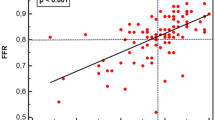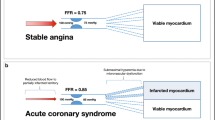Abstract
Analysis of coronary flow velocity pattern has been used to assess microvascular function post acute myocardial infarction (AMI). This study sought to analyze whether the flow level has an impact on parameters of coronary flow velocity pattern. Parameters of coronary flow velocity pattern were determined at baseline and during increased flow due to maximal hyperemia induced by adenosine in 25 patients after PTCA for first AMI using Doppler flow wires. Patients were divided into those with depressed (global wall motion index (GWMI) ≥ 1.5; n = 14) and those with preserved (GWMI < 1.5; n = 11) left ventricular (LV) function at 4 weeks. Coronary flow velocity pattern at rest was different between patients with depressed and patients with preserved LV function at follow-up. A difference in flow pattern between the groups remained at increased flow level. However, increase of flow altered parameters of flow pattern. Diastolic deceleration rate (DSR) increased for patients with preserved LV function (53.7 ± 25.6 at baseline vs. 67.0 ± 29.8 cm/s2 with adenosine) and depressed LV function (95.3 ± 58.6 vs. 110.7 ± 61.4 cm/s2, respectively, p = 0.0012). Induction of hyperemia resulted also in increased systolic and diastolic peak flow velocity and diastolic deceleration time (DDT). Higher flow had no impact on early systolic retrograde flow, systolic flow duration and diastolic–systolic velocity ratio (DSVR). The coronary flow velocity pattern allows prediction of LV function at 4 weeks after AMI. However, it should be considered that some parameters of the flow velocity pattern are affected by the coronary flow level.
Similar content being viewed by others
References
Ito H, Tomooka T, Sakai N, et al. Lack of myocardial perfusion immediately after successful thrombolysis. A predictor of poor recovery of left ventricular function in anterior myocardial infarction. Circulation 1992; 85: 1699–1705.
Roe MT, Ohman EM, Maas AC, et al. Shifting the openartery hypothesis downstream: the quest for optimal reperfusion. J Am Coll Cardiol 2001; 37: 9–18.
Neumann FJ, Blasini R, Schmitt C, et al. Effect of glycoprotein IIb/IIIa receptor blockade on recovery of coronary flow and left ventricular function after the placement of coronary-artery stents in acute myocardial infarction. Circulation 1998; 98: 2695–2701.
Gregorini L, Marco J, Kozakova M, et al. Alpha-adrenergic blockade improves recovery of myocardial perfusion and function after coronary stenting in patients with acute myocardial infarction. Circulation 1999; 99: 482–490.
Suryapranata H, Zijlstra F, MacLeod DC, van den Brand M, de Feyter PJ, Serruys PW. Predictive value of reactive hyperemic response on reperfusion on recovery of regional myocardial function after coronary angioplasty in acute myocardial infarction. Circulation 1994; 89: 1109–1117.
Mazur W, Bitar JN, Lechin M, et al. Coronary flow reserve may predict myocardial recovery after myocardial infarction in patients with TIMI grade 3 flow. Am Heart J 1998; 136(2): 335–344.
Iwakura K, Ito H, Takiuchi S, et al. Alternation in the coronary blood flow velocity pattern in patients with no reflow and reperfused acute myocardial infarction. Circulation 1996; 94: 1269–1275.
Kawamoto T, Yoshida K, Akasaka T, et al. Can coronary blood flow velocity pattern after primary percutaneous transluminal coronary angioplasty predict recovery of regional left ventricular function in patients with acute myocardial infarction? Circulation 1999; 100: 339–345.
Akasaka T, Yoshida K, Kawamoto T, et al. Relation of phasic coronary flow velocity characteristics with TIMI perfusion grade and myocardial recovery after primary percutaneous transluminal coronary angioplasty and rescue stenting. Circulation 2000; 101: 2361–2367.
Wakatsuki T, Nakamura M, Tsunoda T, et al. Coronary flow velocity immediately after primary coronary stenting as a predictor of ventricular wall motion recovery in acute myocardial infarction. J Am Coll Cardiol 2000; 35: 1835–1841.
Tsunoda T, Nakamura M, Wakatsuki T, et al. The pattern of alteration in flow velocity in the recanalized artery is related to left ventricular recovery in patients with acute infarction and successful direct balloon angioplasty. J Am Coll Cardiol 1998; 32: 338–344.
Rossen J, Winniford M. Effect of increases in heart rate and arterial pressure on coronary flow reserve in humans. J Am Coll Cardiol 1993; 21: 343–348.
Baumgart D, Haude M, Liu F, Ge J, Goerge G, Erbel R. Current concepts of coronary flow reserve for clinical decision making during cardiac catheterization. Am Heart J 1998; 136: 136–149.
Lepper W, Hoffmann R, Kamp O, et al. Assessment of myocardial reperfusion by intravenous myocardial contrast echocardiography and coronary flow reserve after primary percutaneous transluminal coronary angioplasty in patients with acute myocardial infarction. Circulation 2000; 101: 2368–2374.
Schiller NB, Shah PM, Crawford M, et al. Recommendations for quantitation of the left ventricle by two-dimensional echocardiography. American Society of Echocardiography Committee on Standards, Subcommittee on Quantitation of Two-Dimensional Echocardiograms. J Am Soc Echocardiogr 1989; 2: 358–367.
Kan G, Visser CA, Koolen JJ, Dunning AJ. Short and Long Term Predictive Value of Admission Wall Motion Score in Acute Myocardial Infarction. A cross sectional echocardiographic study in 345 patients. Br Heart J 1986; 56: 422–427.
Ito H, Maruyama A, Iwakura K, et al. Clinical implications of the 'no reflow' phenomenon. A predictor of complications and left ventricular remodeling in reperfused anterior wall myocardial infarction. Circulation 1996; 93: 223–228.
Gibson CM, Murphy SA, Rizzo MJ, et al. Relationship between TIMI frame count and clinical outcomes after thrombolytic administration. Thrombolysis in Myocardial Infarction (TIMI) Study Group. Circulation 1999; 99: 1945–1950.
Holtz J, Forstermann U, Pohl U, et al. Flow dependent, endothelium-mediated dilation of epicardial coronary arteries in conscious dogs: effects of cyclooxygenase inhibition. J Cardiovasc Pharmacol 1984; 6: 1161–1169.
Abizaid A, Kornowski R, Mintz GS, et al. Influence of guiding catheter selection on the measurement of coronary flow reserve. Am J Cardiol 1997; 79: 703–704.
Donohue T, Kern M, Aguirre F, et al. Assessing hemodynamic significance of coronary stenosis: analysis of translesional pressure-flow velocity relations in patients. J Am Coll Cardiol 1993; 22: 449–458.
Matsumura K, Jeremy RW, Schaper J, Becker LC. Progression of myocardial necrosis during reperfusion of ischemic myocardium. Circulation 1998; 97: 795–804.
Author information
Authors and Affiliations
Rights and permissions
About this article
Cite this article
Hoffmann, R., Lepper, W., Heussen, N. et al. Impact of flow level on coronary flow velocity pattern. A doppler flow study in patients with first acute myocardial infarction. Int J Cardiovasc Imaging 20, 27–35 (2004). https://doi.org/10.1023/B:CAIM.0000013157.14656.9e
Issue Date:
DOI: https://doi.org/10.1023/B:CAIM.0000013157.14656.9e




